Heath Town Works
| The Heath Town Works were built on an 18 acre
site which was purchased from the Government Disposal Board in
1925-26
after being used as a wartime munitions factory producing
phosphorous poison gas during the First World War. The
works factory was officially opened by the Duke of
Kent in October 1931 after three years of rebuilding. In the 1920s, Mander Brothers Limited was set up by
Charles' son, Charles Tertius Mander Bart., his son Sir Charles Arthur
Mander, Bart., Gerald Poynton Mander, Sir Geoffrey Le Mesurier Mander
and Howard Vivian Mander. |
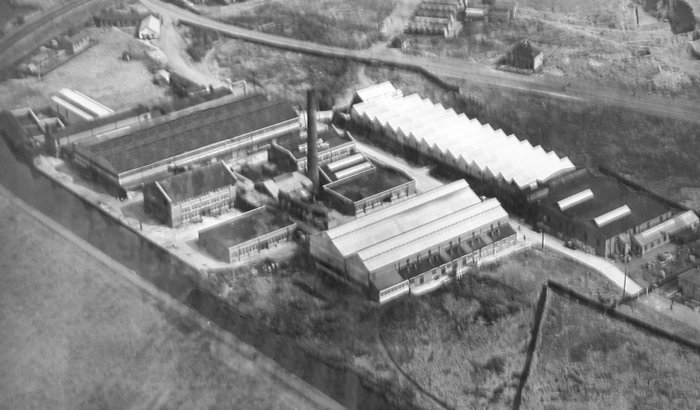
Heath Town Works in 1932.
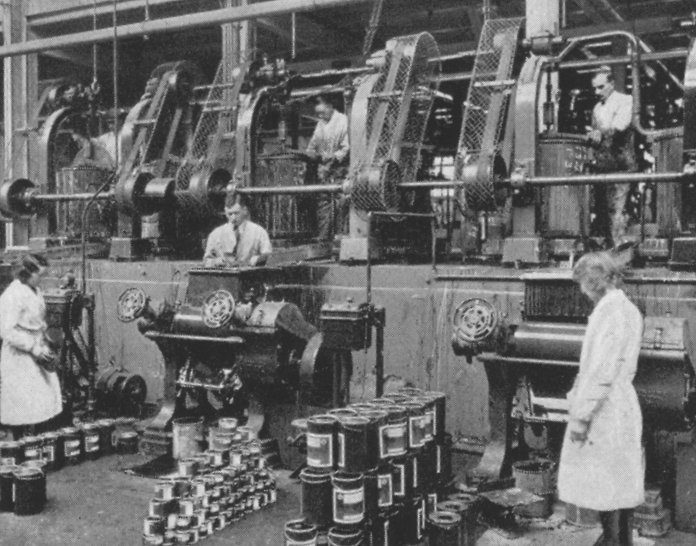
Filling tins of paint.
|
In 1937 the printing ink interests merged with John Kidd &
Company Limited to become one of the largest printing ink
manufacturers in the U.K.
In the same year the public company Manders (Holdings) Limited
was formed, gathering together in one major grouping, all the
specialised companies, now operating successfully at home and
abroad. In 1945 the Wednesfield Works were sold to Griffiths
Paints.
|
|
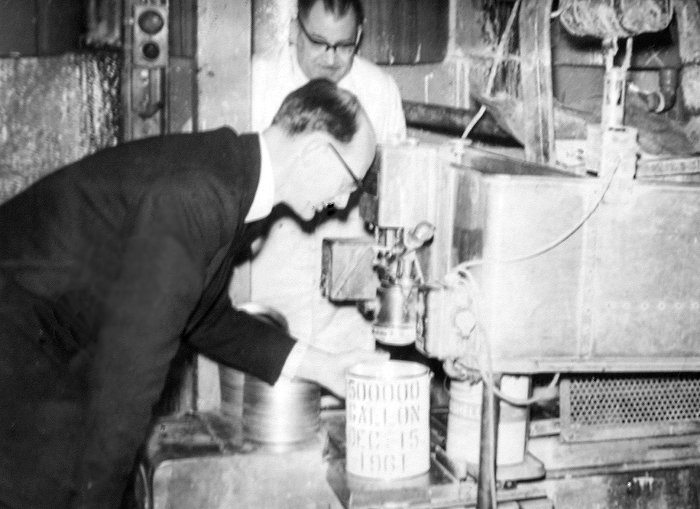
In 1961 the company produced
its 500,000th gallon of paint. The photograph shows the tin
being filled. |

Some of the staff. Back row left to right:
Bill Hillier, Arthur Crowe, Ted Pascall, Frank Bache, W. G., Ken
Phillips, Horace Punter, Joe Law, Ben Fletcher, Jim Bradley,
Bert Dwight, Arthur Davies, Ken Bird, Tom Gibbons, ?, and Bob
Knight.
Middle row left to right: Iris Downing, Mrs. Draper, ?, Joan
Swift, Jim Walker, Hazel ?, ?, Jean Roberts, and Kath
Potts.
Front row left to right: ?,?, Jack Preston, Jack Whitehouse, and
? |
|

A photograph of Heath Town Works taken in
the 1950's. |
|
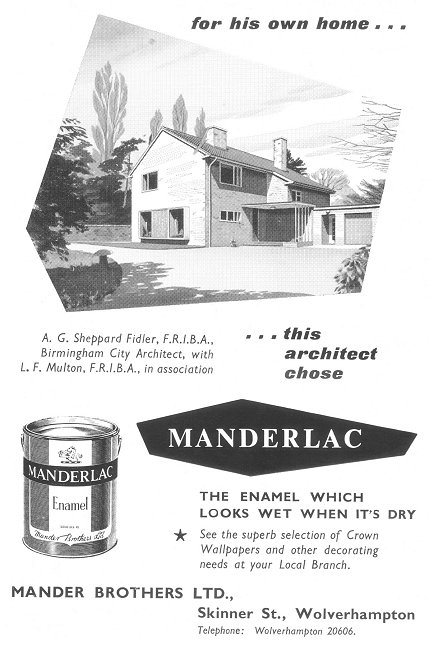
An advert from 1958. |
By the 1970's Heath Town works had expanded to cover
an area of over 20 acres and the company employed over 1,000 people.
Mander's products were distributed through 50 U.K. service centres
and agencies throughout the world.
In 1972, Philip Fitzgerald Mander, who had been Chairman of the
public company, died, and the family took a less active role in
the business.
The company continued to be as successful as ever,
and following the success of its decorative paints, it acquired
other manufacturing companies, whose products would compliment
its own.
In 1973 Manders acquired British Domolac Limited, an
industrial paint company, and Mander's Industrial Paints Division was
added to it. The company then started to trade as Mander-Domolac
Limited.
|
|
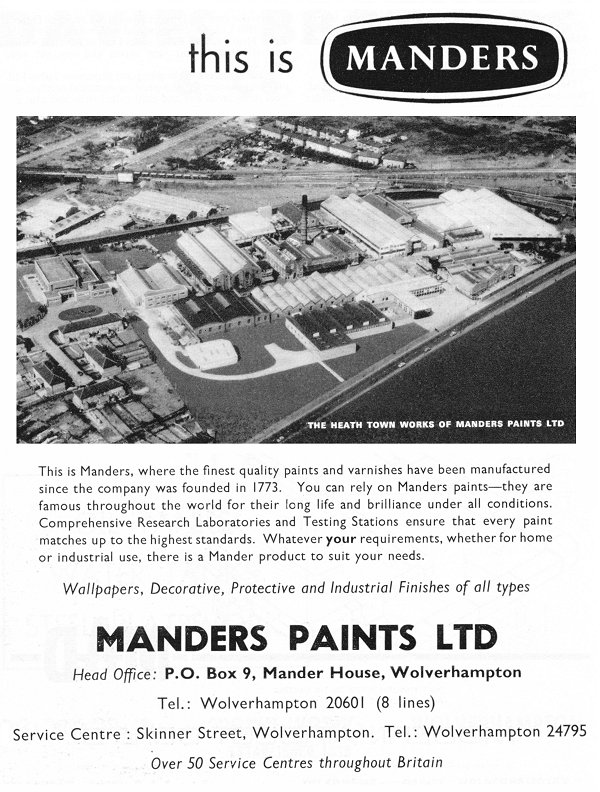
From the 1970 Wolverhampton
Handbook. |
|

In 1971 Manders produced
their one millionth gallon of paint. The photograph shows part
of the celebrations. |
|
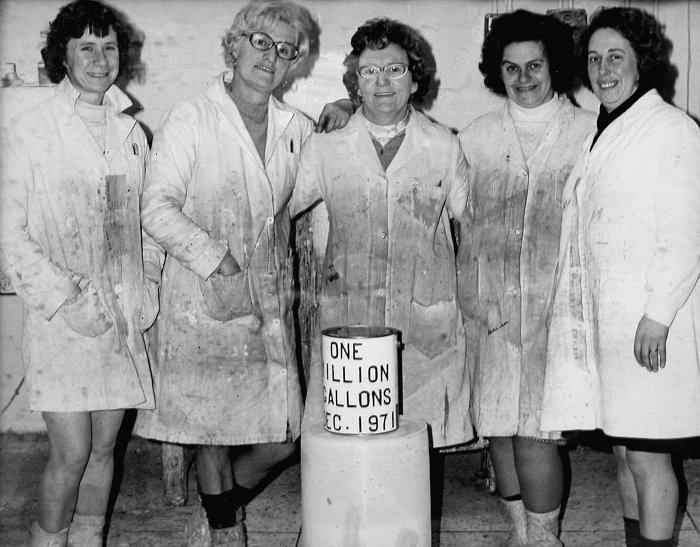
Another photograph showing
the one millionth gallon of paint. |
| One of Mander's
better known customers was 10 Downing Street. The famous front
door used to be painted with Manders paint.
|
 |
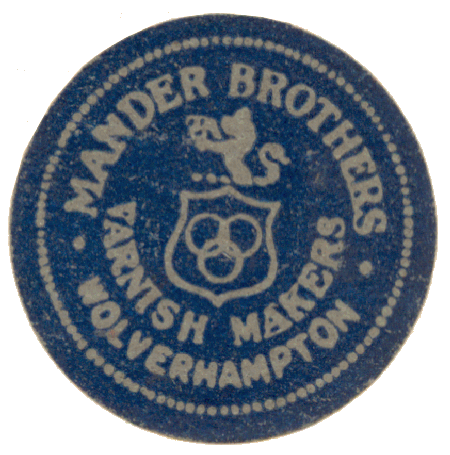 |
A paper label of an unknown date. |
| The photograph shows staff
and volunteers at the Springburn Museum in Glasgow.
The museum
acquired the North British built steam locomotive, Garratt 4112
after its withdrawal from service in South Africa.
The
locomotive needed repainting, which was made possible by
sponsorship from Manders, who supplied the paint.
Mander's paints
were ideal for the purpose as Manders used to supply paint to
British Rail. |
 |
|
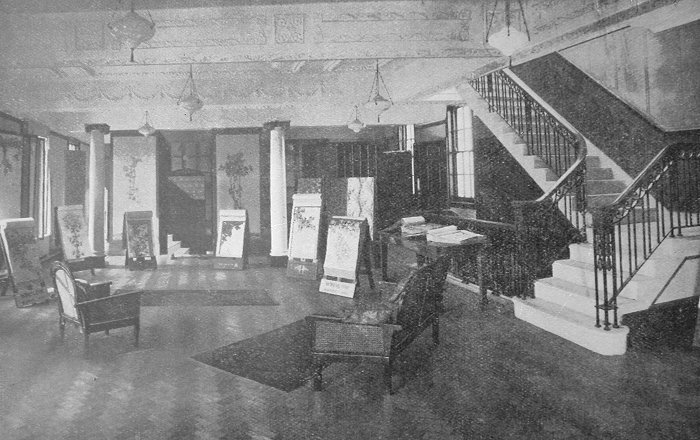
The wallpaper showroom in Mander's
shop in Skinner Street, Wolverhampton.
|
|
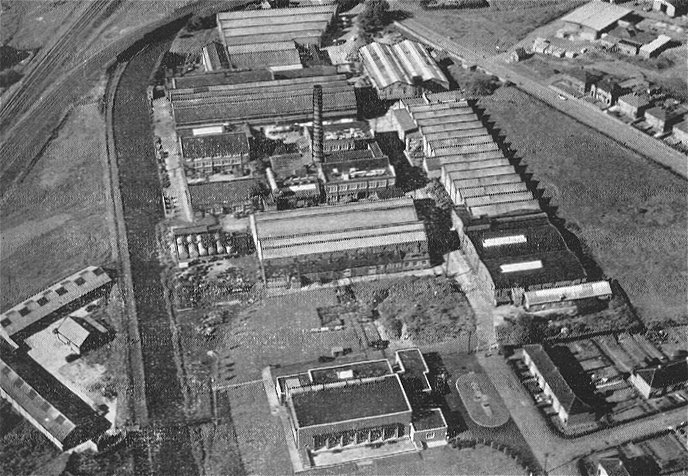
Another view of Heath Town Works
in the 1950s. |
|
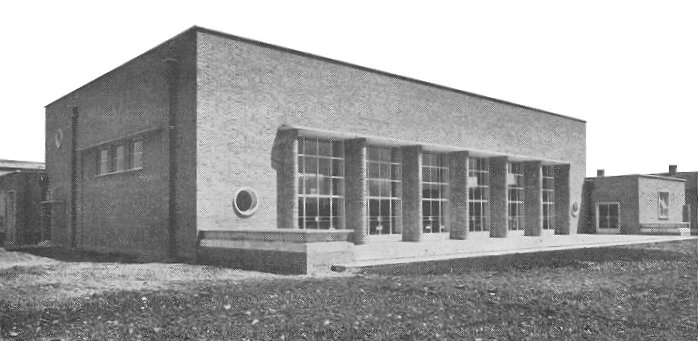
The Works Canteen at Heath Town. |
|
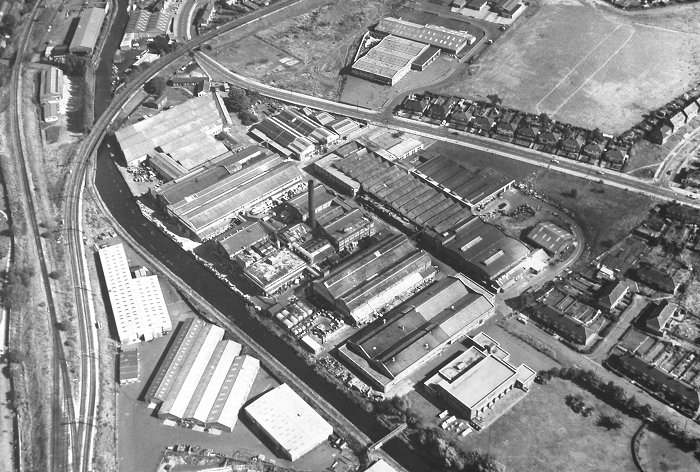
A view of the factory from the
late 1950s. |


A group photo, believed to be
from 1947. Back row: Harold Drew, Tom Lloyd, and
Edwin Amies. Middle row: Eric Carter, ?, Ethel
Guteridge, ? Front row: Jack Blunn.
Courtesy of Ralph Hickman. |

The Liquid Ink Laboratory
in 1967. The people in the photograph include
Bob White, Doug Roberts, S. Cross, D. Clifton,
and M. Gwilliam. Courtesy of Ralph Hickman. |

Charles Beaumont
retired as Chairman of Mander Kidd in 1969.
This photo was taken at his retirement party
in Skindles Hotel, Maidenhead, on the 28th
May, 1969. The people are as follows:
Front row: Alec May, Donald McInnes, Arthur
Lees, Charles Beaumont, Les Cockelton, Frank
Stoyle, and Derek Adams.
Back row: George Whitfield, Alan Capstick,
Tom Allamson, Peter Brown, Gordon Priestly,
Charles Newton, Bob Clachus, Peter Hickman,
Bob Watkins, Harold Hyde, Alec Barr, and Reg
Wilshire.
Courtesy of Ralph
Hickman. |
|

A group photo
taken outside the works canteen at Heath
Town, in 1969. Courtesy of Ralph
Hickman. |

A member of
the photographic section of Mander
Brothers Welfare Club, washing a
print in the darkroom. Courtesy of
Ralph Hickman. |

Peter
Hickman was a member of the
photographic section. This is
his set of rules. Courtesy of
Ralph Hickman. |

The factory in the
early 1970s.
|

The
installation of a new boiler
chimney in 1981. Courtesy of
Ralph Hickman. |
|

The canal, as seen from
the factory on a
winter's day in the
early 1980s. Courtesy of
Ralph Hickman. |
|

Another view of the
canal, taken on the
same winter's day in
the early 1980s.
Courtesy of Ralph
Hickman. |
|

The works yard
taken during the
same cold snap.
Courtesy of
Ralph Hickman. |
|

Another view
of part of
the site
during the
cold snap.
Courtesy of
Ralph
Hickman. |
| In the 1980s Manders acquired QC Colours and
Johnson and Bloy, and integrated them into the company by
forming a new division in 1989 called Manders Liquid Ink
Division. It was headed by Managing Director, John Mackenzie,
formerly of QC Colours.
A new decorating centre was opened at Heath Town in 1990 and
the new headquarters of Mander-Deval Wallcoverings was built on
land adjacent to the works. In 1992 an unsuccessful takeover bid from a rival
company, Kalon, led to Manders reviewing its long-term strategy. The decision was taken to concentrate on the highly
successful printing ink manufacture and so, during late 1993 and
early 1994, the decorative paints part of the business, and the
Mander Centre, were sold. |
|
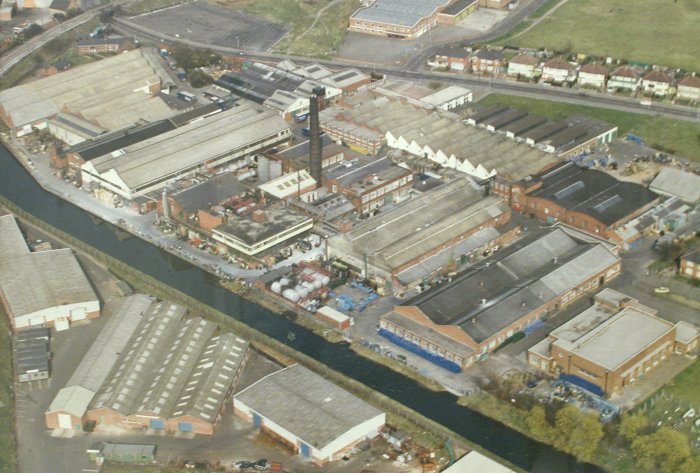
Heath Town Works in 1984. |
| Manders also acquired a number of the world's
leading ink manufacturers, including a major competitor, Croda, with
operations in the U.K., Ireland. Italy, the Netherlands, New
Zealand, South Africa and the USA.
In 1994 the Netherlands based Premier Inks was acquired. It was
one of Europe's largest manufacturers of publishing inks. In the same year Morrison Inks of New Zealand was also acquired to give
Manders a strong world-wide presence.
In 1996 Manders made its final acquisition with the purchase
of a large facility in Sweden which specialised in metal
decorating coatings. Six centres of excellence were set up in
various European locations, specialising in commercial sheetfed
inks, liquid inks, metal decorating inks, news inks and
publication inks.
The company invested heavily in research and development
to ensure that its products kept ahead of the competition and satisfied
customer's needs. The Wolverhampton factory became the Centre of
Excellence for the manufacture of coldset inks, which are fast drying
inks for use in newspapers. Most of the national and provincial
newspapers used inks that were manufactured in Wolverhampton, and the
company also supplied many newspapers throughout Europe. Printing ink
sales increased from £40 million in 1993 to £160 million in 1997. About
60 countries were supplied through 28 manufacturing and distribution
centres. |

The factory in July 1988 after
the completion of a new 450,000 cubic ft. tin store. This was
part of a two million pound investment at the works, in modern
production equipment and improved storage facilities. |
| In 1998 Manders was acquired by the Flint Ink Corporation
of America. This is the largest privately-owned ink manufacturer in the
world. The Heath Town works became the European Headquarters of Flint
Ink Europe, and the remainder of the works closed and has since become
Manders Industrial Estate, which is now home to a variety of companies. |

 |
|
 |
|
 |
Return to
John Street |
|
Return to
the contents |
|
Proceed to
Mander-Kidd |
|